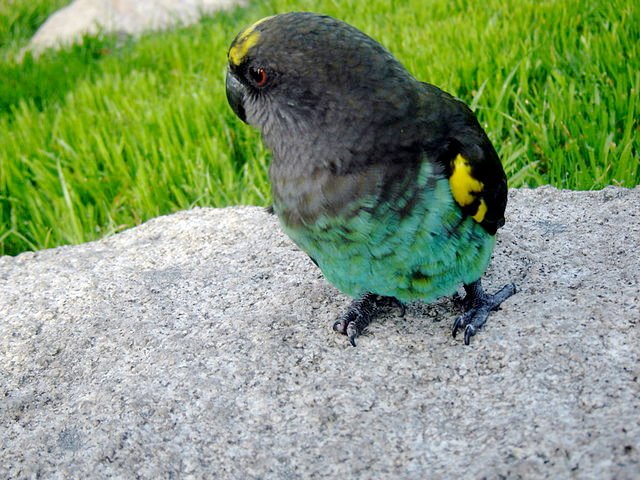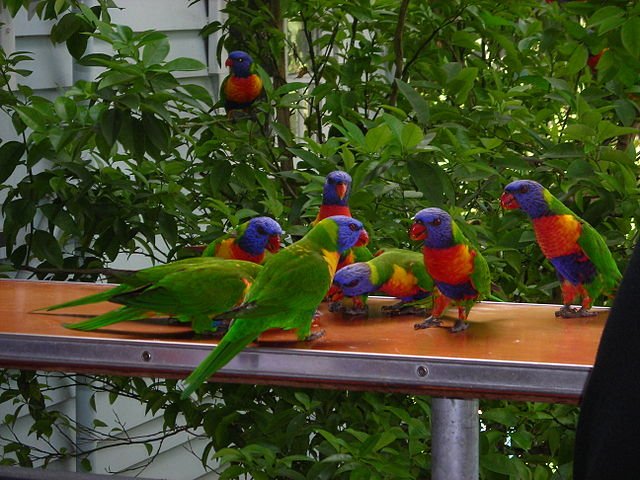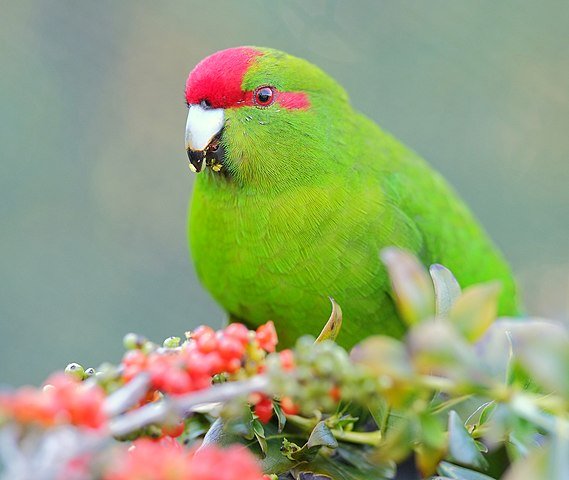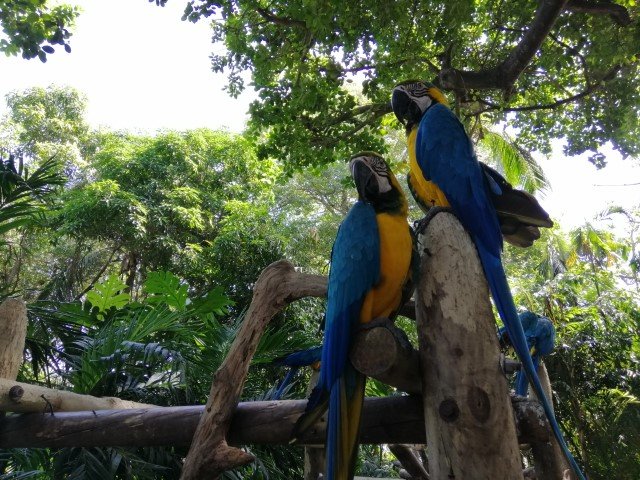Meyers parrots (Poicephalus meyeri) are a type of parrot that is native to Africa. They are named after the German naturalist and explorer Bernhard Meyers, who first described the species in 1836.
Meyers Parrot Lifespan
The average life span of a Meyers parrot in the wild is between 20 and 30 years. The Meyers parrot lifespan in captivity is up to 55 years. However, this is dependent upon several factors, such as their general health, diet, and wellbeing.
Here are a few things to help your Meyers parrot live a long and healthy life.
- One of the most important things you can do to ensure a long and healthy life for your Meyers parrot is to take them to the vet for regular check-ups and vaccinations.
- Provide it with a clean and spacious cage with space for them to fly about.
- Make sure your parrot has at least 30 minutes of exercise per day, though more is better.
- Meyers parrots are very intelligent, and they need to be kept challenged to stay healthy and happy. Providing them with toys and puzzles to keep their minds active will help them live longer, healthier lives.
- A healthy diet is a key to keeping your Meyers parrot in tip-top condition. Meyers parrots need a diet that is high in nutrients and low in fat.
Meyers Parrot Size
Meyers parrots are medium sized parrots, typically measuring around 9 inches in length and weighing about 4 ounces. Males and females are both the same size.
Meyer’s Parrot Color
Meyer’s parrots come in a variety of colors, including gray, green, yellow, blue, and white. Meyers parrot mutations include lutino (all-yellow), albino (all-white), and piebald (partially colored).
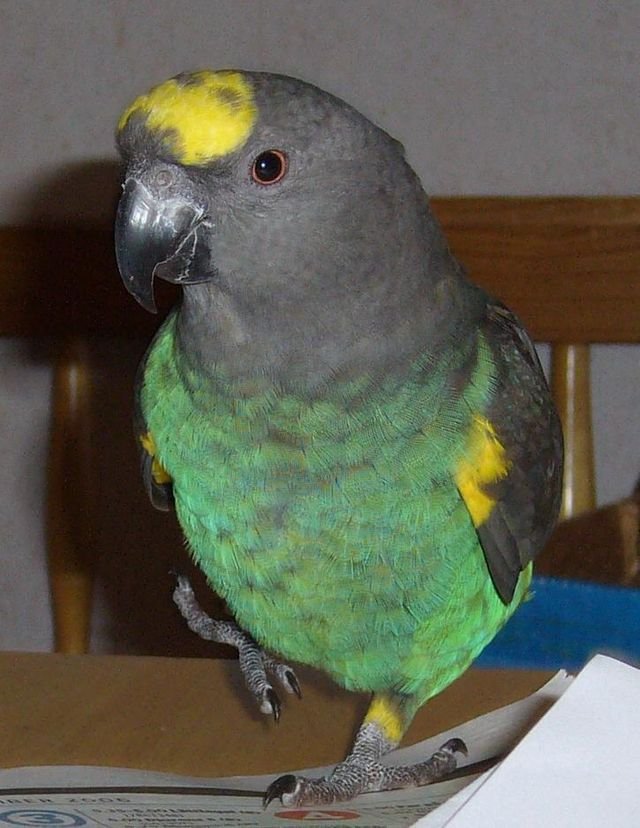
The colors and patterns of Meyer’s parrots can vary depending on their geographical location. For example, parrots from Africa are typically more brightly colored than those from South America.
Meyer’s parrots are also known to change colors as they mature; younger birds tend to be more brightly colored than older birds.
Meyers Parrot Breeding
Meyers parrots are not difficult to breed, but there are a few things to keep in mind. The Meyers parrot breeding age is 3-4 years old, so make sure your pair fit this requirement. You can tell when they are ready to breed, as the Meyers parrot mating behavior involves mating dances from the male, and the female will be looking for suitable nesting material.
Make sure you have a nest box ready, the ideal size is 18” high and 10” square. The female will lay anywhere from 3-4 eggs, which will hatch after about 28 days. Meyers parrot eggs are small, around 1” in size, and white in color. The young will fledge (leave the nest) after about ten weeks.
If you are looking for Meyers parrot babies for sale, make sure they are hand fed parrots and used to human contact. This will help you to bond with your new parrot much easier as they will already be used to humans.
Meyers Parrot Gender Difference
It’s not easy to differentiate males and females, as they are not sexually dimorphic, meaning that the males and females look alike. Even experienced Meyers parrot breeders have a hard time telling the difference between the sexes.
However, there are some differences that can help you to determine whether your Meyers parrot is male vs female. Males are more talkative and have a higher-pitched call. Females often tend to be quieter, and their call is much lower than male birds.
Meyers Parrot Talking Ability
Meyers parrots are known for their talking ability, and they can learn a variety of words and phrases. Meyers parrots typically start talking at around six months of age.
However, they are not as good at imitating human speech as some other parrot species. They are more likely to learn words that have a specific meaning to them, such as the names of people or objects, or may pick up on sounds around the home such as alarms or appliances.
Meyers Parrot in Apartment
Thinking about keeping a Meyers parrot as a pet? Thanks to their small size, Meyers parrots don’t take up too much space meaning they work well in an apartment. However, Meyers parrot care is still important to consider.
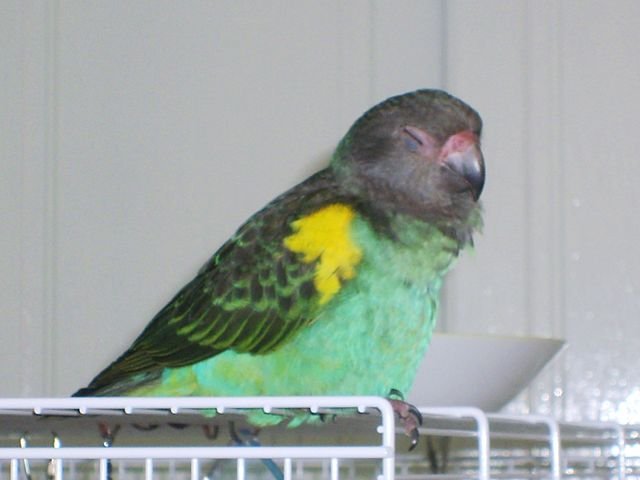
Are they noisy? Meyers parrot in general have high squawk sound, but not too loud. They are suitable for keeping in apartment and noise will probably not go beyond your walls.
Meyers Parrot Behavior
Meyers parrots are known for being very active and playful. They are also very curious and love to explore their surroundings. They are social birds and enjoy being around people and other birds.
Is a Meyers parrot cuddly? They are calm and birds by nature and are excellent for families with children. They are easy to handle and are not intimidating birds. Humans are enjoyable to them, and they will keep friendships with everyone in the family. Meyers parrots are not known to be aggressive, but they can become nippy if they feel threatened or scared.
Meyers Parrot Body Language
Meyers parrots also communicate using their body. Signs of a happy parrot include preening, taking regular baths, tail wagging, and sleeping on one foot. If you notice a decline in these behaviors or something strange you have not noticed before, it may be a sign something is not quite right.
The Meyers parrot call is often a lot of screeching which can increase not only when they are happy but also when they are startled. As a result, make sure that the Meyers parrot cage is away from any distractions that might scare it.
When they are ready to breed, the Meyers parrot mating dance involves a lot of vocalization and the male parrot will move from side to side on its perch.
Meyers Parrot Cage
When getting a cage for your Meyers parrots, you should consider a few things to make sure you get the best cage for your bird. Follow these guidelines, and you’ll be sure to get a great cage for your Meyers parrot!
The cage should be big enough for your Meyers parrot to move around comfortably.
Meyers parrots are small to medium-sized birds, so their cages should be appropriately sized. The minimum cage size for a single Meyers parrot is 24″ x 24″ x 24″, but a larger cage is always better.
If you have the space, a 36″ x 36″ x 36″ cage would be ideal. The cage bars should be no more than ½” apart to prevent your parrot from escaping or getting stuck.
The cage should have plenty of perches and toys for your Meyers parrot.
When choosing a cage for your Meyers parrot, make sure that it is big enough for them to move around freely and stretch their wings. It should also have plenty of perches and toys for your Meyers parrot to play with.
Therefore avoid cages with sharp edges or small bars that could hurt your bird, and make sure the cage is placed in a safe, quiet area where your bird can feel comfortable, including out of the reach of other pets and small children.
Clean the cage regularly.
Once you have got your cage, you should remember that you will need to clean it regularly. Meyers parrots are very clean birds, and they will not tolerate a dirty cage. A dirty cage can lead to serious health problems for your bird.
Meyers Parrot Price
Meyers parrots are relatively affordable, with prices ranging from $400 to $1500. The price will depend on the age and quality of the bird. Its not most popular bird in stores so it will be hard to find Meyers in pet shops. The best way to look for it is local breeder. Average price for Meyers parrot is 1000$.
This is just the cost of the parrot itself, so it’s just part of overall expenses. Here are some costs you need to keep in mind:
The cost of a cage or aviary
The cost of a cage or aviary will be the most significant initial expense when purchasing a Meyers parrot. A good-sized cage or aviary for a Meyers parrot can cost anywhere from $200 to $1,000.
The cost of food and toys
The cost of food and toys can add up quickly. A good quality diet for a Meyers parrot can cost around $40 per month, and toys can cost anywhere from $10 to $30 each.
The cost of vet care
Meyers parrots are relatively low-maintenance as far as pets go, but they still require regular vet care. Expect to pay $50-$100 per year for routine check-ups and vaccinations. If your bird becomes sick or injured, you may have to pay for more expensive treatment, costing hundreds or even thousands of dollars. As a result, it’s worth having a good pet insurance policy to help cover unexpected medical expenses.
Meyers Parrot Diet
Meyers parrots are omnivores, meaning they eat both plants and animals. That means that Meyers parrots are not picky eaters, and they will eat just about anything. However, there are some things that Meyers parrots should not eat, such as chocolate, avocado, and caffeine.
Their diet consists of fruits, vegetables, seeds, nuts, and insects in the wild. In captivity, you can feed them a diet of pellets, vegetables, fruits, and occasional live foods.
Fruits and vegetables
Meyers parrots are known for being particularly fond of fruits and vegetables. In captivity, they should have a diet of about 50% fruits and vegetables. Great ones to feed your parrot include apples, bananas, oranges, carrots, and dark leafy greens.
Seeds
In the wild, a Meyers parrot will eat various seeds, so their diet should consist of a variety of them to ensure they are getting all the nutrients they need. The best seeds for Meyers parrots are sunflower seeds, safflower seeds, and millet.
Nuts
Meyers parrots are particularly fond of nuts and will often hoard them in their nests.
You can also give them nut-based treats, like almond or peanut butter. A great nut for enrichment as well as nutrition is a walnut, which requires a bit of work from your parrot to break the shell to get to the nut inside! Just be sure to give them in moderation, as nuts are high in fat.
Pellets
Meyers parrots should have a diet that consists mainly of pellets. Pellets are a complete and balanced food that contains all the nutrients your parrot needs. This doesn’t mean that their diet should be entirely pellets, as a good combination of pellets, fresh fruit and vegetables, and assorted nuts and seeds are essential to a balanced diet.
Live Food
Meyers parrots enjoy eating a variety of live foods. Some of their favorites include crickets, mealworms, and waxworms. You can purchase these insects at most pet stores. Be sure to offer a variety of sizes to your parrot, as they will enjoy trying to catch them.
It is vital to offer your Meyers parrot a variety of foods to ensure that they get all the nutrients they need. From time to time, you also can give them some treats like cooked rice, pasta, or beans. But avoid giving them processed foods, sugary foods, or salty foods.
Meyers Parrot with Other Parrots
The Meyers parrot is part of the poicephalus family of birds, and as a result, they aren’t very keen on socializing with other birds unless they are a matched breeding pair. Meyers parrots are quite independent birds, and often tend not to get on with other birds in captivity. Even though cockatiels are quite good-natured birds, a Meyers parrot and cockatiel would need a careful introduction, or the pair would need to be in separate cages. The same can be said for Meyers parrots and other breeds, such as Conures, Senegals, and Quakers.
If you are looking for a friendly, small parrot with a good nature, a Meyers parrot may be the pet for you. As with all animals, just make sure to do your research so you know what you are getting into.
